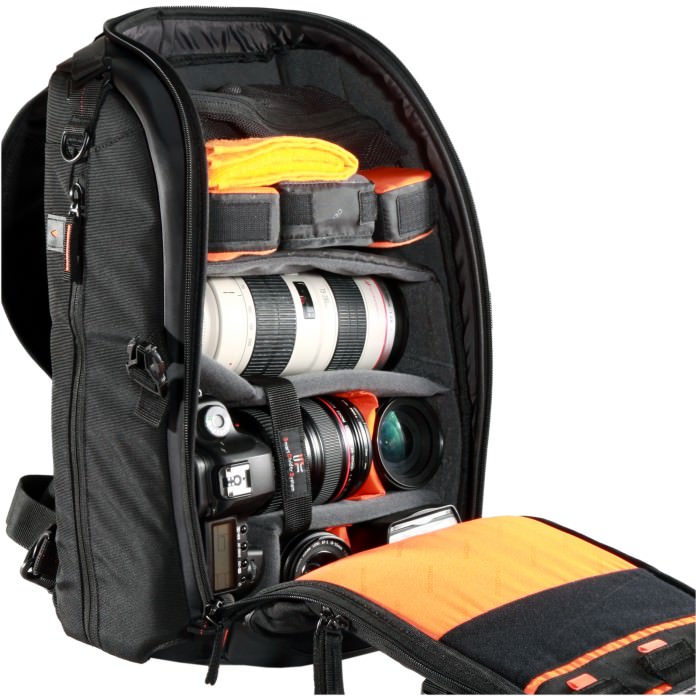
 Once you're invested in your photography gear, you're going to want to know that you're transporting it around securely and in style. To help you pick the right tool for the task, take a look at our guide for choosing a camera bag.
Once you're invested in your photography gear, you're going to want to know that you're transporting it around securely and in style. To help you pick the right tool for the task, take a look at our guide for choosing a camera bag.
Choosing a camera bag that perfectly suits your needs is a difficult task. If you have a modest kit, do you buy one to fit the gear you have or allow for expansion? If you have a larger system, do you get one big bag to house all of your gear, or do you only take selected items out at a time?
The truth is, there is no perfect bag and most photographers end up with several, which they’ll use for different occasions.
Before choosing a bag, think about the type of photography you do. If, for example, you’re a landscape photographer then a backpack may be the best choice for you. If travel photography is your passion you’ll want to take your gear as hand luggage, and may also want it to hold your passports and tickets, newspaper or small laptop. You might want to also pack a smaller shoulder bag for use once you get to your destination.
There are over a dozen major bag and case brands in the UK, each with their own design ethos. None are right, or wrong – in the end, once you’ve chosen the right type and size of bag for your needs, the rest comes down to personal taste. Here’s our guide to help you choose.
Factors to consider
Capacity
How big a bag do you need? You may have lots of gear, but do you want to carry all of it with you? The type of photography you do will influence the bag you’ll need. Into sports or wildlife? You’ll need one that can hold a big telephoto lens. Travellers, on the other hand, will want something smaller.
At CameraWorld, we try and tell you precisely what will fit in to every bag. The best way to chose the right size is simply to bring all your gear along to one of our shops and try them out for yourself. It's amazing what you can shoehorn in but, unfortunately, there are no 'Tardis' bags!
Materials
Top Camera bags are made from a variety of materials. Natural fibres (eg. canvas, cotton, leather) are used in top end bags and offer a luxury, ageless quality that you will enjoy for many years, while man-made hi-tech materials offer higher performance – lighter, better water-resistance etc, and they often have easier access, are more comfortable to carry and have cleverer dividing arrangements.
Protection
There has been a lot of development in the protection 'foam' in camera bags, especially in high end ones. This allows for a fairly thin foam to offer a high level of protection without taking up too much space. A bag’s water-resistance is very important. Look out for exposed zips that can let in water, or flaps that don’t offer a good seal. Some bags come with a waterproof cover, like a big shower cap, which you can pull over the bag if it rains.
Comfort
An uncomfortable bag will kill your desire to go out and take pictures. A bag that sits too low, a strap that digs into you, a harness that cuts into your back – in some cases this is due to bad design, but it’s also because we’re all different shapes. Try your bag out before buying – ideally with weight in it.
Type of Bag
If you have a bridge camera or DSLR with a single lens, then the snout-shaped zoomster may be for you. They come in various sizes and all feature a main tapered cavity which holds your camera. Most feature a couple of accessory pockets.
For small cameras. Most can fit on a trouser belt and many will have an additional pocket for media cards, batteries and maybe a few other bits.
Some large cases come with built-in wheels and a handle, like airport luggage, for ease of transportation. These are aimed more at getting your gear from A-B than using on a shoot.
The main advantage of shoulder bags is that, unlike backpacks, you can get to your kit to change lenses etc while walking along. The drawback is that all the weight is on one shoulder, which, if the bag’s heavy, can cause discomfort after a while. Messenger bags are like shoulder bags only thinner, and are usually worn across the body. There’s usually less padding and their lack of depth makes big cameras problematic.
Can’t decide between a shoulder bag and backpack? These go on your back like a rucksack, but you can often access your gear by swinging it round to your front rather than having to remove it. Some backpacks are designed to hold more than just your camera equipment. Many will have space for sandwiches, books, as well as attachments for tripods.
For those who are shooting in the field, there are backpacks that securely hold everything – and we do mean everything – from two pro sized bodies, to lenses such as a 70-200mm f2.8.
Hard cases are generally made from plastic resin. Inside is either a set of dividers, or a block of foam diced into cubes, which you customise to your needs. They’re designed for transportation, usually either in the boot of a car or on an aeroplane. Some, are waterproof and virtually indestructible.
These are designed either by the camera manufacturer or by a leading bag supplier to fit specific cameras. These are usually leather or faux leather and take inspiration in their design from some of the camera cases of years gone by.
Some compact cameras will have an underwater mode. This doesn’t mean the camera is waterproof – far from it. These cases are designed to let the camera work, and for you to operate the camera at depths beyond normal paddling. Many are designed to go up to a depth of 30metres and are strenuously tested to tackle the issues of water pressure without compromising on the operation of your camera.
You may already have a case for your camera equipment that is just perfect, but then you buy a new lens. These lens cases are designed for fit any and all lenses and usually attached easily to another bag.
These are as they say. Designed for various tripods and head combinations especially if the tripod didn't come with a case in the first instance. Some are simple thin, nylon bags with no protection for the tripod or you! If you need to carry a large, heavy studio tripod, a padded case is an important consideration.
Most travel tripods come with a simple zip bag to carry and these are more than adequate, especially if you're fitting it to the outside of a camera bag/backpack. There are even camera bags coming along now that have pockets for the tripod to go INSIDE, a great innovation.










